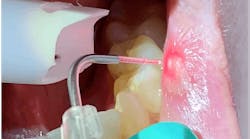Why tracking your patients is THE most important thing you can do to grow your dental practice
3 dental practice statistics that you must start tracking today!
Photo credit: Dreamstime.com
I was on a conference call recently with a colleague who said something that really resonated with me: “If you trust your gut, keep in mind that your gut is full of crap.” I talk to doctors daily who tell me about their practice. I always ask about the number of new patients that they have and where they come from. Without fail, they will give me an estimate that ends up being significantly more patients than they actually end up having. They also usually have no idea where these patients are coming from and if they are even retaining them. This is scary.ALSO BY SASHA BURAU, MBA |What we can learn from McDonald's and other wildly successful companies
Multimillion-dollar companies invest a lot of time and energy into knowing their customers, their habits, and where to place their marketing. Most dentists do zero marketing and of those who do marketing, most do it either sporadically or they go off of their gut and market where they think their patients are. This is generally not a good idea.
ALSO BY SASHA BURAU, MBA | The top 7 mistakes of high-performing practices
The key behind any type of marketing is consistency, so whatever you are doing, you need to continue doing it. Think about companies that have commercials on TV. No company would run just one commercial on one network, one time. The key is to have the same commercial run multiple times on multiple different networks. People need to be reminded about you and your product so that when they are ready to “buy,” they buy from you.
There are three main opportunities that practices are not tracking.
Disclaimer: There are many things that you should be tracking (production, collections, new patients, accounts receivable) but these are three things that most practices do not track, and I would consider these to be lost opportunities. Regardless of what you track or don’t track, there is power in knowing the numbers.
So, let’s begin with the most basic type of patient tracking that needs to take place in a dental office ...
Tracking where new patients are coming from
How you can track this
Regardless of whether or not you do marketing, you need to track where all of your new patients are coming from. This is easy, but if your staff is uncomfortable doing this, include it on a new patient questionnaire or on your health history form that all new patients fill out or as a part of your new patient hygiene note. If this is not something that you are currently tracking, you should find a way to automate it. This almost guarantees that you will collect this data.
What should you do with this information?
At the end of every month, you should have your front office staff compile this information for you. If most of your patients are coming from referrals, expand your referral base and start asking for referrals. If most of your new patients say that they just “drove by,” follow up that question by asking them if they visited your website. You will be surprised to hear how those two go hand in hand.
What you should know
People don’t just see you somewhere and decide to come to your dental office. Mercedes did a study and found that on average, it took six experiences for their customer to buy. An “experience” is an interaction with the product or service that precipitates an action. Experiences could occur when someone drives by your building, checks out your website, and then talks to a coworker about your practice.
But how do you track that
You don’t. There is no way that you can track all of that, but when you find that you are getting a lot of patients from a particular source, you want to invest more time and money into that source. If you don’t know what that source is, it’s pretty hard to know where to invest more money, time, and energy.
Fish where the fish are
Another benefit of knowing who your new patients are and where they are coming from is knowing where to keep fishing! Most dentists hate to spend more money marketing, but it is even more frustrating when the money that you’re spending isn’t bringing in any new patients.
Last fall, my office had a very ineffective external mailing campaign. We ended up scheduling and seeing three new patients from our postcards. We were extremely frustrated. I talk to many of you who have had the same experience. So, before we threw money at the latest and greatest in marketing, we took at look at our new patient habits from the previous 12 months. This was extremely helpful. We discovered that our best new patients were internal referrals. These people accepted treatment, showed up for their appointments, and had the highest value per new patient. So, we have invested our money and time into making our existing patients feel good about us and asking for referrals. Our second best referral source is our website and the Internet, so we are planning on spending more time developing this area of our marketing. But if we didn’t know this, we would have spent more money and more time on something that wasn’t working in our area.
Once you have a handle on where your new patients are coming from, you need to find out where they are going.
Tracking new patient recall appointments and treatment scheduled
As I’ve mentioned in previous articles, I work for my dad and my uncle in their practice. My husband is in dental school at the University of Southern Illinois, and my brother is in dental school at Midwestern University. My husband is a D3, my brother is a D2, and my dad jokes that he is a D31 (we just tell him he’s old!). So, my dad has been out of dental school for 27 years and let’s just say that in those 27 years he saw 200 new patients each year, which would be a total of 5,400 new patients over his entire career.
The reality is that patients move, they die, they switch dentists, and it is not possible to retain 5,400 patients over a career. But there are some things we can do to improve the percentage that we keep.
As a general rule, with all new patients, I find that:
- One-third of new patients will stay in your practice and do the treatment that you recommend
- One-third will stay and may not do the treatment that you recommend today, but they may do this treatment in six months or a year
- One-third will leave, not necessarily because of you or your staff (that’s a possibility too), but for whatever reason, that’s just what happens
While it is very important to increase your new patient numbers, it is more important to keep the ones you are already getting!
How can you increase the number of patients you keep? You need to know your patients are going. I recently started tracking this at our office. Here’s what my new patient tracking sheet looks like:
How you can track this At the end of the month, have your front office staff compile this information for the new patients you saw.
What should you do with this information?
Keep track of how many patients are leaving your office with a next appointment. If patients aren’t accepting treatment but they are making their next recall appointment, you are more likely to retain them as a patient. Track this and meet with your staff to review it. The old adage, “You don’t know what you don’t know” really applies here. If you aren’t aware that you are not retaining patients, you cannot do anything about it.
What you should know
The best way to retain a patient is to get them scheduled while they are in your office. The longer that it takes for them to schedule a next appointment, the less likely are to come back.
Ancillary benefits of tracking this
You will get a good idea of:
- If patients aren’t scheduling treatment, why they aren’t scheduling
- If patients from a particular referral source aren’t scheduling treatment
- If one of your hygienists or assistants isn’t scheduling them before they leave
- If you are finding that patients aren’t scheduling treatment due to financial reasons, you may need to work on your case presentation or you may need to offer more financial arrangements options to make the cost more palatable.
- When we tracked this, we found that patients from external marketing were significantly less likely to accept treatment and schedule a recall appointment, so we started an internal referral campaign.
- If a particular hygienist or assistant is consistently not scheduling a next recall appointment or if their patients are regularly not scheduling treatment, you should meet with them to discuss ways to improve this.
- If you are not seeing a pattern with a particular hygienist or assistant who is not reappointing new patients, you may have a systems issue. This could mean that when the hygienist or assistant transitions the patient over to the doctor or the front desk, one person may think that the appointment was already made. Or, one person thought the other person was going to educate the patient about why recall is so important and then make the next appointment.
And one more thought
My goal with every new patient is that they leave with a next recall appointment. I have found that our new patient value is significantly higher in the second and third years of being our patient. Treatment planning is a personal style, but acceptance is significantly higher if they continue seeing you as their dentist; make this a priority.
Here’s the other thing to keep in mind with new patients. When you go to the car dealership to look for a new car, most people don’t buy the first one they try. They look around, get comfortable with it, and do their research. Dental patients are the same way! They may not trust you yet and may need more time before they are ready to have you do their treatment.
The final missed tracking opportunity
Treatment recommended and scheduled
Dental consultants sometimes talk about a short call list or a cancellation call list. I have yet to come across an office that has a consistent list of patients that they can call if there is a cancellation. (I used to think I would be more likely to see a unicorn or Bigfoot than to see this mythical short call list!). But the secret is that every office has the potential to put this into place and at the same time track whether treatment that is recommended is actually scheduled.
This is what my form looks like:
How you can track this
Keep a few spreadsheets like this and have your front office write down the names of patients who need treatment and whether or not they schedule.
What you should do with this
When you have a cancellation, this is your list of patients to call. This may be a good sample dialogue:
“Mrs. Jones, this is Sally from Dr. Smith’s office. Dr. Smith is very concerned about that tooth on the upper left that he talked to you about, and he wanted me to give you a call. We actually have an opening this afternoon if you are interested in having that taken care of.”
And make your way down the list.
Why this is important
Dr. Earl Estep used to call his office manager every morning and see how much production was scheduled for that day. If there were not enough production scheduled for that day, he would tell her that he was going to bed until there was enough production for him to come into the office! I have never heard about what he did if he showed up and there were a ton of cancellations! But when you have cancellations, your front desk needs to go into recovery mode. When you work in unscheduled treatment, this is great because you are increasing your production when your overhead is fixed and your staff is already there. When we have cancellations, you still have that same overhead. Many times, your front desk just doesn’t know who to call.
When to use this
We use this two times:
- When we have a cancellation
- When tomorrow’s schedule falls apart
We covered cancellations already but, like I mentioned above, when the schedule falls apart for tomorrow or this afternoon, we need to get into recovery mode. My rule is that if by today at noon, tomorrow’s schedule is light, we devote this afternoon to filling it. Sometimes this is a difficult mindset for team members to grasp because they already have a lot to do — posting checks, filing insurance claims, etc., but filling the schedule is the most important thing that they can do. This becomes significantly more efficient if they have a list of patients to call.
One final thought
If the doctor discusses treatment with a patient and no one else in the office mentions or tries to schedule this treatment, it doesn’t validate what the doctor is recommending. If during the handoff to the front desk, the assistant or hygienist reiterates to the front desk person the importance of the treatment that was recommended, that is one more opinion that the patient will hear. We find that even though patients trust the doctor, they look to the staff to tell them what they should do. This is especially important with new patients. So, if you call and remind them of the importance of the recommended treatment after they didn’t schedule, it shows the patient that you value their dental health and you are concerned about them.
I have found that many problems in practices could be avoided just by knowing your numbers. At the absolute least, every month you should receive a report of:
- Production
- Collections
- Collection percentage
- Number of new patients
- Number of days worked
Ideally, you would have a report that also included accounts receivables for 30, 60, and 90 days and your overhead. When you know what your numbers are, you can make more educated decisions about how to grow your practice.
Not sure where to start? Email [email protected] for more FREE business tips and for any of these spreadsheets that were mentioned. When we figure out the business part, you can get back to focusing on what you should be doing: dentistry!










